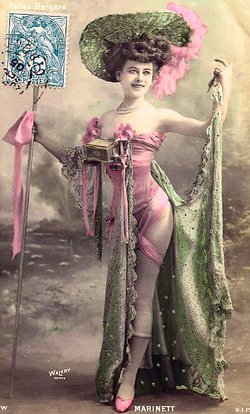|
|
The Folies Bergère is a Parisian music hall which was at the height of its fame and popularity from the 1890s through the 1920s. As of 2004 the institution is still in business.
Located at 8 rue Saulnier, in the 9th Arondissement, it was built as an opera house by the architect Plumeret. It opened 2 May, 1869 as the Folies Trévise, with fare including operettas, comic opera, popular song, and gymnastics. It was renamed the Folies Bergère on 13 September 1872.
Edouard Manet's 1882 well-known painting A Bar at the Folies-Bergere depicts a bar-girl, one of the demimondaine, standing before a mirror.
FolliesBergereCostumesBW.jpg
The Folies Bergère catered to popular taste. Shows featured elaborate costumes; the women's were frequently revealing, and shows often contained a good deal of nudity. Shows also played up the "exoticness" of persons and things from other cultures, obliging the Parisian fascination with "négritude" of the 1920s.
In the early 1890s, the American dancer Loie Fuller starred at the Folies Bergère. Nearly thirty years later, Josephine Baker, an African-American expatriate singer, dancer, and entertainer, became an "overnight sensation" at the Folies Bergère in 1926 with her suggestive "banana dance", in which she wore a skirt made of bananas.
Other notable Folies Bergère performers have included singers Maurice Chevalier and Louisa Baileche and comedian Cantinflas.
FolliesBergereTableau.jpg
The Folies Bergère inspired the Ziegfeld Follies in the United States and other similar shows.
External link
- Official site (http://www.foliesbergere.com)
- Les Folies Bergères (http://www.cabaret.netfirms.com/les_follies_bergeres.htm)

